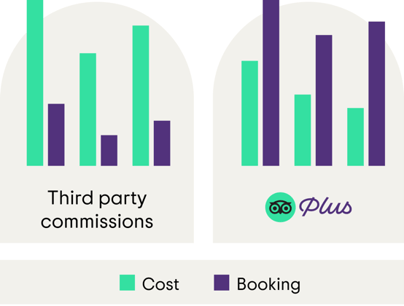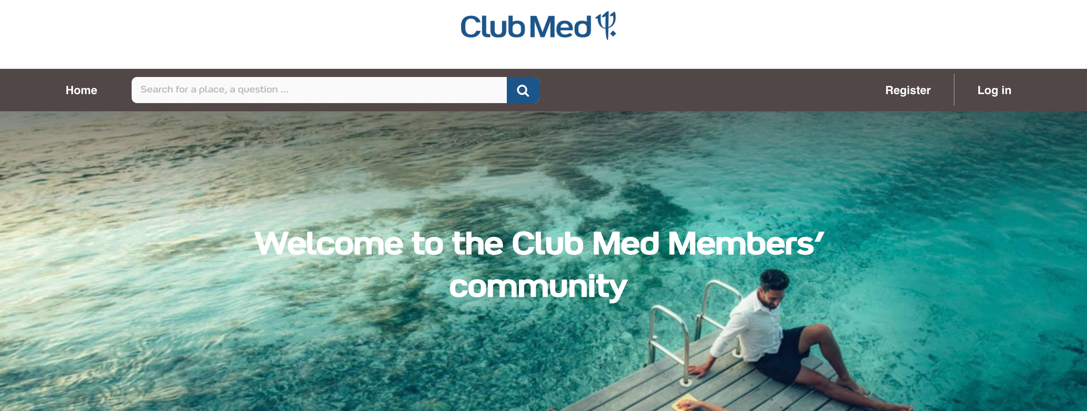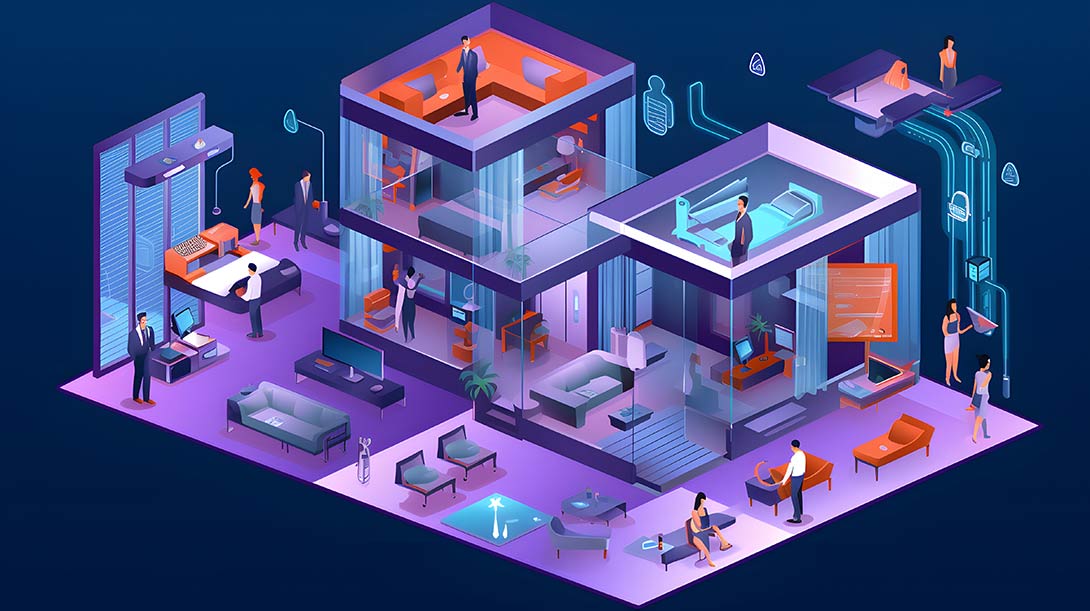While the pandemic was raging on, TripAdvisor did not simply contend with having to wait out the storm. Indeed, not unlike other big platforms such as Booking.com, the COVID-19 outbreak was a time for change and self-reflection for the leader of travel review websites. And as we will see, the result of this year-long brainstorming throws a lot of our past assumptions regarding the hospitality market out of the window…
Prior to the pandemic, TripAdvisor’s business model revolved almost exclusively around advertising. By taking advantage of its massive website traffic (around 150 million visits per month), the company provided a click/transaction-based advertising kit to hotels and other booking platforms. Concretely, hotels and OTAs alike could choose to move their profile up the result page in exchange for either a CPC (cost per click) or CPT (cost per transaction) fee. Another source of revenue came from a display-based advertising model, which included, for example, website and newsletters banners on either a per-impression or subscription fee.
More recently, TripAdvisor also expanded its business and subscribed to the affiliate programs of some of the leading accommodation websites such as Booking.com. In a nutshell, TripAdvisor would operate as a business operator for various OTAs and the commission for each booking would be split between both parties.
While these revenue flows are based on known business models shared by many similar companies, TripAdvisor’s latest idea looks to be much more ambitious than its predecessors.
Enter TripAdvisor Plus
TripAdvisor Plus (TAP) is a new B2C subscription program introduced via a Beta testing phase in December 2020 and officially launched in June 2021 offering discounts and perks in a selection of hotel partners for 99$ a year. The membership also provides savings on external activities such as tours, theme parks and attractions referred to as “experiences”. While, for now, TAP is still only available in the US, the fact sheet claims that more than 100k hotels and 400k “experiences” are already available and providing discounts.
On the hotels’ side, connectivity is possible either via GDS platforms such as Amadeus (which comes with the usual commission) or affiliate channel managers (which charge no commission) to pull up rates and availabilities. By joining the program, TripAdvisor claims that hotels will get more value per booking (see picture below), increased visibility on the platform as well as more high-intent guests which are likely to spend more once at the hotel. As for KPIs, partnered hotels can expect an additional 20% more clicks on their page, which would lead to increased demand.
 TripAdvisor Plus promises hotels more value through fewer commissions (Source: TripAdvisor)
TripAdvisor Plus promises hotels more value through fewer commissions (Source: TripAdvisor)
While this idea is not actually that new or innovative (European start-up Bidroom has been providing a similar program since 2016), the sheer scale of the TripAdvisor platform is bound to bring the subscription model to new heights. Indeed, even though major hotel brands are yet to join the program, you can count on TripAdvisor to give itself the means to achieve its ambitions. As a very well-versed company when it comes to marketing, one can expect TripAdvisor to quickly tap into a wide audience through large-scale marketing campaigns (some of which are already running on American TV).

TAP’s marketing efforts are already in full swing (Source: TripAdvisor YouTube)
Time will tell if the subscription model will actually stick in the long run, although the more interesting story lies elsewhere. It is undeniable that TAP is a product of its time as it was thought by TripAdvisor during the pandemic as an answer to the upcoming transformation of the online travel landscape. By deconstructing the program one feature at a time, we can get a sense of what the hospitality industry of the future looks like according to TripAdvisor’s predictions.
In the next section, we will take a step back and analyze four key characteristics of TripAdvisor’s new subscription program. Then, for each of them, we will aim to decipher where TripAdvisor is coming from with each of these features. Finally, we will outline key takeaways hotels can learn from TripAdvisor’s strategy as well as concrete actions they can take to adapt to this new market.
Taking the bird’s eye view
When thinking about the creation of TAP, one has to put things back into their context. After years of relying on mostly advertising and OTAs affiliate program for revenue, TripAdvisor was hit hard by the COVID-19 outbreak. With online marketing as well as online bookings coming to an abrupt halt, TripAdvisor had to completely rethink how to do business. More importantly even, TripAdvisor needed to think ahead to the post-pandemic world and imagine a sustainable model that would take into account the many transformations that reshaped the industry. As we know, the result of this is TAP and it includes multiple features that would have seemed out of place in a pre-COVID-19 travel market. Below are a few of them:
Moving away from the OTA model
A few years ago, the online travel market had reached something of a status-quo, with every actor holding a seemingly immutable position. OTAs would drive most new bookings, with just a small portion of direct bookings coming from the most loyal customers, and all other sources of non-online booking slowly but surely dwindling. As such, if TripAdvisor were to enter the B2C travel market at this exact moment, the OTA model looked like a prime candidate. However, the COVID-19 outbreak changed everything.
Indeed, the first signs of recovery in the summer of 2020 saw a huge drop of bookings coming through OTAs in favor of other mediums, most notably direct channels. Besides, OTAs such as Booking.com are currently changing their platform in order to reclaim those lost market shares. Needless to say that the commission-based model used by OTAs must have felt a lot less enticing for TripAdvisor all of a sudden.
This is likely one of the reasons that prompted TripAdvisor to think outside of the box and switch the bearer of the cost from the hotel to the guest. By doing so, TripAdvisor is anticipating a change in the way people envision online booking in the long run. Furthermore, TAP proving successful would spell even further trouble for OTAs and the commission-based model.
Key Takeaway: The current travel environment is ripe for change and innovation. The tide is turning against OTAs, and TripAdvisor decided to make a move in a bid to earn some of their market shares. In the near future, hoteliers should aim to be less reliant on OTAs for their bookings (especially since they are starting to enforce more restrictive conditions) and should not hesitate to make bold, innovative changes, and promote their direct channels.

Nurturing a sense of community
One of the keys to a successful subscription model is knowing how to leverage a sense of community or belonging within the subscriber base. In order to grow TAP, TripAdvisor will need to nurture a community built around one shared passion: travel. Fortunately, TripAdvisor has a head start as the company can rely on its almost 900 million registered users to target the most qualitative profiles and start building a solid core of early adopters for TAP. Once the ball gets rolling, word of mouth will become the company’s best marketing tool to expand TAP’s subscriber count.
Concretely, the bet TripAdvisor is making in launching TAP is that its users’ passion for travel will outmatch COVID-induced restrictions and other quarantines. Despite the dire context, TAP is a testament to the hopes TripAdvisor places in the power of community and in the resilience of the hospitality industry.
Key Takeaway: Don’t underestimate the power of community! Nurturing a sense of belonging around your hotel can help build loyalty and start generating recurring revenue. For hotels, this might involve launching a loyalty program, interacting with guests on social media, sending promotional coupons/offers to your guests and merchandising.

Club Med is a great example of a brand built around its community (Source: Club Med)
Launching amidst the pandemic
The timing of the TAP launch is telling regarding how TripAdvisor envisions the recovery of the hospitality industry. Indeed, TripAdvisor could have easily chosen to hold back the launch of TAP until after the pandemic. Nevertheless, they made the conscious decision to kick-off the product in June after 6 months of beta testing, which likely gave the company insurance that the moment was right. In fact, the company did not hesitate to start million-dollar marketing campaigns to promote the product despite travel still being restricted in many parts of the world.
These decisions send a strong message regarding the recovery of the hospitality industry: TripAdvisor believes that, even amidst a global pandemic, travel is bound to regain momentum in the short term. Perhaps the best testament to this hopeful prediction is the slogan for TAP: Travel is BACK!
Key Takeaway: If TripAdvisor’s predictions are to be believed, hoteliers should be ready for an uptick in bookings, at least in the US, in the near future.
Paying now to get discounts and perks later
Unlike a lot of subscription models out there, entering the TAP program does not grant anything right off the bat. Subscribers are willing to pay now for a chance to pay less later and/or get additional perks when staying at a hotel.
This model speaks volumes to the power of promotions, perks, and discounts in the world of travel post-COVID-19. It is no secret that guests love feeling special and personally catered to (in the higher-end hotels, personalization has become one of the cornerstones of the guest experience); and TripAdvisor decided to take advantage of this exact niche.
Key takeaways: Personalized perks and discounts are something you can directly transpose to the hotel business, with many solutions on the market to facilitate it (CRMs, upselling, personalized pricing). These are proven to be great ways to build loyalty, outmatch competition and simply increase overall guest satisfaction and revenue, especially in the hyper-competitive post-pandemic hospitality market.
Parting words
The COVID-19 outbreak and its subsequent lockdown periods saw the flourishing of the subscription model across multiple industries. Be it for streaming services (Netflix, Disney+…), e-commerce memberships (Amazon Prime), or video calls (zoom, skype), sources of recurring revenue proved crucial for companies to overcome the pandemic. In launching TAP, TripAdvisor expects the travel market to be in the right spot to adopt a subscription membership.
As we saw in this article, the numerous assumptions TripAdvisor is making in launching TAP are the fruits of a long period of brainstorming and reflection regarding the future of the industry. The picture it paints is one of hopes and changes. Indeed, most of our past paradigms have died and been buried, which leaves room for new ideas and innovation to take their place. Whether you actually like the idea TripAdvisor came up with or not, it is undeniable that TAP marks a heavy shift in the way both hotels and guests should think about online travel.
Similar to what we described in our article on how Airbnb adapted to the COVID-19 outbreak, hotels should take a page out of TripAdvisor’s book when building their future strategy. Do not simply contend to return to past ways of working as you risk getting stuck in a dead-end. Rather try taking the bird’s eye view and anticipate how you might adapt your business to fit this wild new world.




